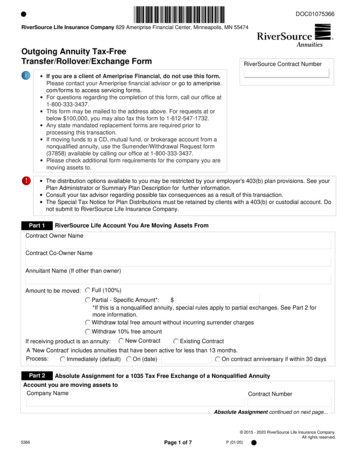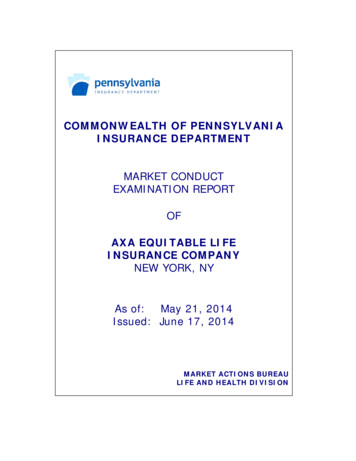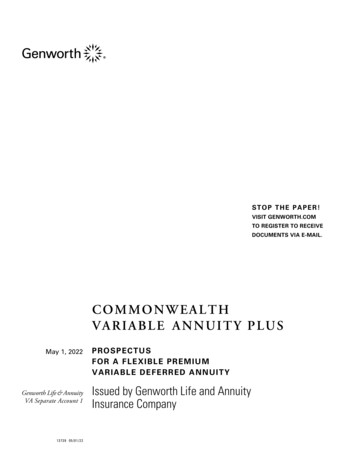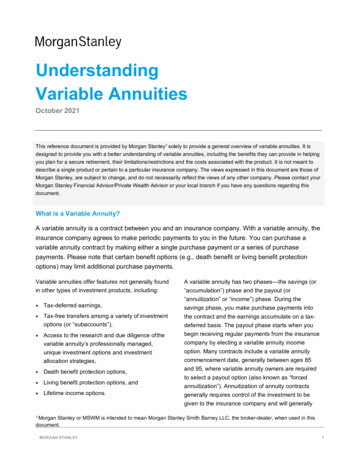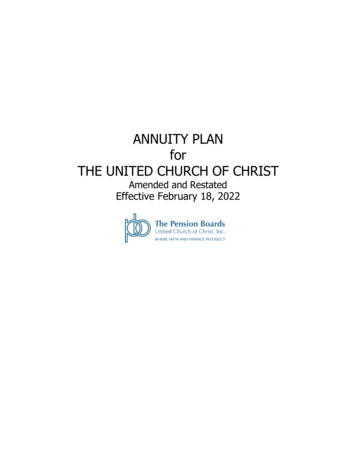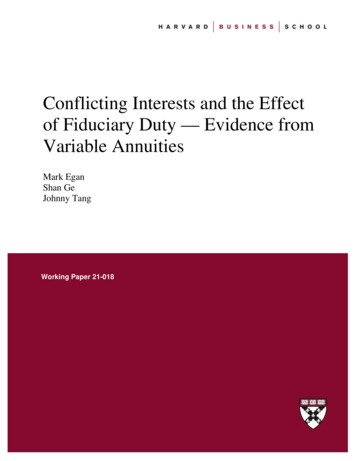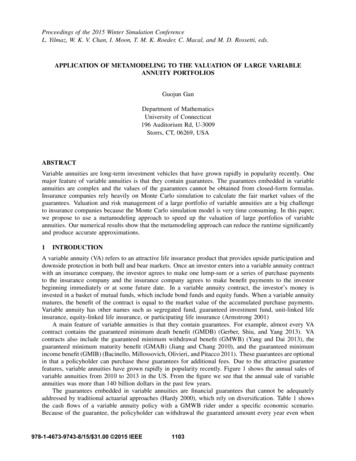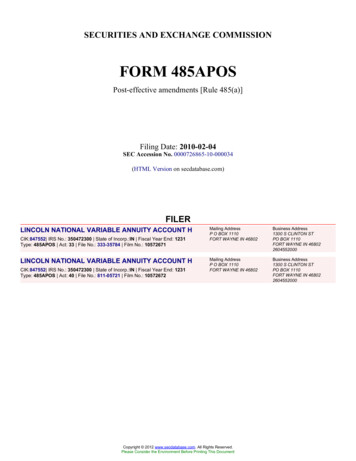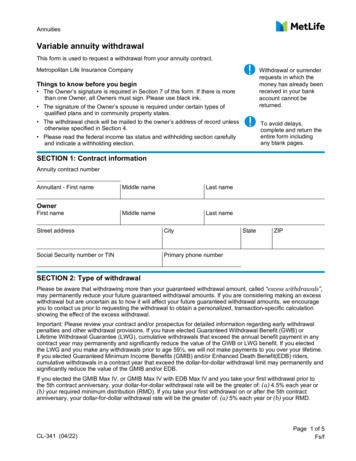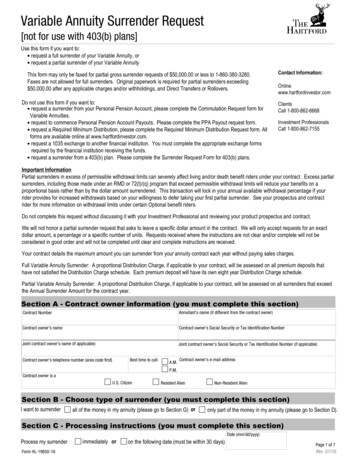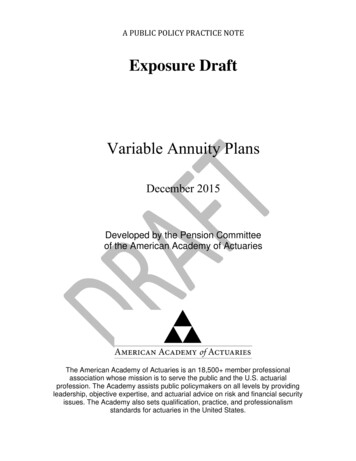
Transcription
A PUBLIC POLICY PRACTICE NOTEExposure DraftVariable Annuity PlansDecember 2015Developed by the Pension Committeeof the American Academy of ActuariesThe American Academy of Actuaries is an 18,500 member professionalassociation whose mission is to serve the public and the U.S. actuarialprofession. The Academy assists public policymakers on all levels by providingleadership, objective expertise, and actuarial advice on risk and financial securityissues. The Academy also sets qualification, practice, and professionalismstandards for actuaries in the United States.
PENSION COMMITTEE PRACTICE NOTE2015 Pension CommitteeEllen Kleinstuber, ChairpersonBruce Cadenhead, Vice ChairpersonMargaret BergerSue Breen-HeldCharles ClarkTimothy GeddesWilliam HallmarkScott HittnerJeffrey LitwinTom LowmanTonya ManningTim MarnellGerard MingioneAlexander MorganKeith NicholsNadine OrloffAndrew PetersonSteve RabinowitzMaria SarliMitchell SerotaJames ShakeJoshua ShapiroMark SpangrudLane WestThe Committee gratefully acknowledges the contributions of former Academy SeniorPension Fellow Donald E. Fuerst.1850 M Street N.W., Suite 300Washington, D.C. 20036-5805 2015 American Academy of Actuaries. All rights reserved.
PENSION COMMITTEE PRACTICE NOTETABLE OF CONTENTSIntroduction. 4Variable Annuity Plan . 4The Mathematical Consequence. 6Guidance from Actuarial Standards of Practice . 11Traditional Liability Measurement of Pure Variable Benefits . 13Potential Liability Measurement of Pure Variable Benefits Under Regulatory Requirements. 15Financial Accounting in the Private Sector. 17Financial Accounting in the Public Sector . 19Single‐Employer Private Sector Funding . 20EROA Consistent With Discount Assumption. 21EROA Independent of Discount Assumption. 24MAP‐21, HATFA, and BBA 2015 Issues . 25Multiemployer Private Sector Funding . 26Public Sector Funding . 27Deviation From the Pure Variable Design . 28Benefits Indexed to a Portion of Plan Assets . 28Benefits Indexed to an External Rate of Return. 29Valuing Variable Annuity Plan Variations. 31Lump Sum Distributions . 34Plans Not Subject to Code Section 417(e). 34Plans Subject to Code Section 417(e). 34Issues Beyond the Current Scope of This Practice Note . 39Appendix. 40American Academy of Actuaries3www.actuary.org
PENSION COMMITTEE PRACTICE NOTEIntroductionThis practice note is not a promulgation of the Actuarial Standards Board (ASB), is notan actuarial standard of practice, is not binding upon any actuary, and is not a definitivestatement as to what constitutes generally accepted practice in the area under discussion.Events occurring subsequent to the publication of this practice note may make thepractices described in the practice note irrelevant or obsolete.This practice note was prepared by the Pension Committee of the American Academy ofActuaries (committee) to provide information to actuaries on current and emergingpractices for measuring obligations of defined benefit pension plans that include variableannuity benefits. Cash balance plans that credit market rates of return are closely related,but are not addressed in this practice note. The intended users of this practice note are themembers of actuarial organizations governed by the actuarial standards of practicepromulgated by the ASB.This practice note addresses several topics that have not yet been formally and explicitlyaddressed by the Internal Revenue Service (IRS), the Department of Labor (DOL), theFinancial Accounting Standards Board (FASB) and the ASB. There is no assurance thatsuch bodies would analyze these topics in the same manner as this practice note.Measurements of defined benefit pension plan obligations include calculations that assignplan costs to time periods, actuarial present value calculations, and estimates of themagnitude of future plan obligations. The application of the information contained hereinis intended to cover qualified and non-qualified plans, and governmental and nongovernmental plans for which the actuary is subject to Actuarial Standard of Practice No.4, Measuring Pension Obligations and Determining Pension Plan Costs or Contributionsand Actuarial Standard of Practice No. 27, Selection of Economic Assumptions forMeasuring Pension Obligations.This practice note addresses issues actuaries should consider when setting assumptions,or providing advice on setting assumptions, for funding (as permitted by law), and forfinancial accounting.This practice note is intended to be illustrative and spur professional discussion on thistopic. Other reasonable methodologies currently exist and new ones likely will evolve inthe future.The committee welcomes any suggested improvements for future updates of this practicenote. Suggestions may be sent to the pension policy analyst of the American Academy ofActuaries at 1850 M Street NW, Suite 300, Washington, DC 20036 or by emailingpensionanalyst@actuary.org.American Academy of Actuaries4www.actuary.org
PENSION COMMITTEE PRACTICE NOTEVariable Annuity PlanA variable annuity plan is a pension plan in which the periodic benefit payable to aparticipant fluctuates based on a formula defined in the plan document. 1 The formulamay define a change in the entire accrued benefit or a portion of the accrued benefit. Ifthe formula change applies to less than the entire benefit, the plan has a bifurcatedformula with both fixed and variable components. The fixed component of the benefitmay be measured using traditional techniques. This practice note addresses only thevariable component of the benefit.The variable benefit formula may apply to all plan participants or only a designatedsubset of plan participants. This practice note addresses only those benefits accrued underthe variable formula.A variable annuity plan is usually a career accumulation plan in which the plan documentdefines the amount of benefit that accrues to a participant each year. The accrual formulacould be based on current compensation (e.g., 1% x pay) or a fixed accrual ( X per yearof service). The accrual for the plan year is generally not dependent on future changes incompensation, as it would be in a final average compensation plan. The annual accrualand the total accrued benefit are expressed as an annual amount payable at NormalRetirement Date (NRD) to the participant in the form of a life annuity. The annuity atNRD could be a single life annuity, or any of the other common forms of annuitytypically available in a defined benefit plan.The periodic adjustments in the plan benefit usually occur annually, but can also takeplace on a monthly, quarterly, or semi-annual basis. Monthly adjustments are common ininsured variable annuity plans offered by some insurance companies. Annual adjustmentsare common in qualified pension plans sponsored by employers. Most illustrations in thispractice note assume annual adjustments, although a “pure” variable annuity plan(defined below) would have adjustments made immediately prior to each payment.Periodic adjustments generally apply to all accrued variable benefits regardless of theparticipant’s status. Thus variable benefits are adjusted periodically for active members,terminated vested members, and retired members. Some variations of variable annuityplans may adjust benefits differently for various membership classes. For example, afixed annuity plan could offer a variable annuity option at retirement or, alternatively, avariable annuity plan could provide a fixed benefit option at retirement.1Treasury Regulation Section 1.411(a)(13)-1(d)(6) defines a “variable annuity benefit formula” as “anybenefit formula under a defined benefit plan which provides that the amount payable is periodicallyadjusted by reference to the difference between a rate of return and a specified assumed interest rate.”American Academy of Actuaries5www.actuary.org
PENSION COMMITTEE PRACTICE NOTEThe plan document defines the exact formula for the periodic adjustment. The mostcommon formula first defines an assumed investment return, often referred to as thehurdle rate. The hurdle rate is expressed as an annual return, typically 3%, 4%, or 5%.Theoretically, any percentage could be used, but there are legal and practical limitationsthat usually confine the hurdle rate to not less than 3% (to comply with minimumdistribution regulations) and seldom more than 6% or 7% (to avoid declining benefits).The hurdle rate is defined by the plan document and it is an integral part of the accruedbenefit.Periodic benefit adjustments are generally defined by comparing the hurdle rate to theactual return on a portfolio of assets for the adjustment period. The plan documentgenerally defines the methodology for determining the actual return on assets. Inqualified plans, the adjustment period is generally the plan year. The portfolio of assetsfor which the actual return is measured could be: The entire plan trustA designated subaccount of the plan trustA specific investment index (e.g., the S&P 500)A specific investment fund (e.g., a mutual fund or a separate account of aninsurance company or investment firm)Assuming a plan that pays and adjusts benefits annually, the plan would generally definethe annual adjustment of benefits for a participant as follows (monthly benefit paymentsand adjustments are discussed below under Variations):Bn Bn-1 (1 in) / (1 h)where Bn is the accrued annual benefit as of the first day of the plan year, in is the actualrate of return on the portfolio of assets during the period between the beginning of year n1 and the beginning of year n (i.e., for the n-1 plan year), and h is the hurdle rate. 2 If in h then Bn Bn-1. The formula makes the name “hurdle rate” clear, as the actual returnmust equal or exceed the hurdle rate to avoid a decline in the benefit.The formula above produces the change in benefit ignoring additional accruals. For anactive participant who is accruing benefits, the formula reflecting the benefit accrual forthe plan year is as follows:Bn Bn-1 (1 in)/ (1 h) INCn-1where INCn-1 is the incremental benefit accrual for service during the year under the planformula (e.g., 1% x annual pay or X, as in the prior examples). A variable annuity plan2Some plans may define the adjustment as: Bn Bn-1 (1 in - h). This variation has some theoreticalbasis for plans that pay monthly benefits but determine the adjustment annually. The slightly largeradjustment compensates for the gains that develop if the actual return is higher than the hurdle rate.American Academy of Actuaries6www.actuary.org
PENSION COMMITTEE PRACTICE NOTEmakes no promise concerning a fixed or guaranteed level of benefits other than thatbenefits already accrued will not vary between scheduled adjustment dates. Benefitscould theoretically go to zero if the portfolio of assets experienced a -100% rate of return(and there were no additional benefit accruals).A pure variable annuity benefit is one in which the plan sponsor can be fully insulatedfrom gains or losses due to investment performance. A pure variable annuity plan wouldhave the following features: benefit adjustments are made immediately prior to each payment for benefits inpay status and at least annually for benefits not in pay status; andbenefit adjustments are based solely on the performance of the assets backing theobligation during the period between benefit payments.The plan sponsor may be fully insulated from investment gains and losses if: benefits are fully funded as they accrue and credited with investment gains orlosses from the time they accrue; anddemographic gains/losses are fully funded as they occur. 3The Mathematical ConsequenceThe appendix provides a mathematical demonstration for a variable annuity showing thatthe assets needed to provide all future benefits are independent of both market interestrates and the portfolio of assets that back the benefit. Thus, it is irrelevant whether theassets backing the benefit are composed of fixed income or equities. To put thisdifferently, if a variable benefit is evaluated using the hurdle rate and an appropriatemortality assumption and the present value is 1 million, the present value is not affectedby whether the 1 million is invested in bonds, equities, or even cash; the amount isexpected to be sufficient regardless, with any variation related only to mortalityexperience different from assumed. The asset allocation will affect how the benefitchanges in the future, but it does not affect the present value needed to provide thosebenefits.There is an important corollary to this rule. If the valuation assumes that benefits will beindexed based on a specific return on assets, then to calculate the initial assets needed toprovide the projected benefits, the projected benefits must be discounted using the samespecific return on assets. The magnitude of the assumption is not relevant, but the returnon assets assumption and the discount assumption must be consistent to determine thenecessary starting assets.3In theory, fully funding a demographic gain would require subtracting assets from the fund. In reality, thisis generally impractical, so instead excess assets resulting from a gain would be offset against the cost ofsubsequent accruals or demographic losses.American Academy of Actuaries7www.actuary.org
PENSION COMMITTEE PRACTICE NOTEThis corollary may also be expressed with the discount rate set first. If the valuationassumes projected benefits will be discounted at a specific rate, then to calculate theinitial assets needed to provide the projected benefits, the projected benefits must beassumed to change based on asset returns equal to the discount rate. Any other assetgrowth assumption will result in a present value that is either inadequate or excessive toprovide the projected benefits.American Academy of Actuaries8www.actuary.org
PENSION COMMITTEE PRACTICE NOTEVariations on Pure Variable DesignA pure variable design can be modified in a variety of ways. These modifications include:Benefit payment frequency different from benefit adjustment frequency: The mostcommon deviation from the pure variable model is monthly payment of benefits withonly annual adjustment of benefit amounts. To facilitate administration, the actual changein benefit amounts is usually delayed a month or more to allow the administrator todetermine these adjustments and implement the change. For a calendar year plan, theactual return on the portfolio of assets is generally determined for the calendar year andbenefit adjustments are typically implemented in February or March of the followingyear, usually without any retroactive adjustment.Separate non-variable floor benefit formula: A plan may provide the better of avariable benefit or a fixed “floor” benefit. This floor benefit may be set based on thesame formula as the variable benefit (e.g., both fixed and variable formulas are 1% of payfor each year of service). Alternatively, it may be set at a different (typically lower) levelto provide some limit on the downward adjustment to the benefit in the event of adverseinvestment experience (e.g., the benefit is the greater of a variable benefit of 1% of pay ora fixed benefit of 0.9% of pay). The floor benefit generally applies to the benefit in total,rather than applying separate floors to each year’s accrual.Grandfathered frozen benefit: When a plan is converted to a variable plan, the changeis usually made prospectively, affecting only future accruals (the so-called A Btransition). However, it is possible to apply the variable adjustment to some or all of theaccrued benefit as well. In such case, for U.S. qualified plans the accrued benefit must beprotected as a minimum, in which case it acts as a floor benefit described above. Overtime, as additional benefits are earned, the floor benefit is likely to become lesssignificant (this is known as “wearaway”). On the other hand, for a participant whoterminates employment shortly after the conversion, the floor benefit promise maycontinue to have significant value.If the variable benefit plan is considered a statutory hybrid plan (i.e., a U.S. qualified planand the hurdle rate is less than 5%), the frozen accrued benefit may need to be maintainedwithout wearaway in addition to all prospective variable benefits. In this case, mostsponsors will likely conclude that the A B transition approach is the only practicaloption.Limit on the annual benefit adjustment: The amount the benefit can be reduced orincreased in any given year may be limited to a specified percentage (e.g., 5%). Anyadjustment beyond this amount may either be carried forward to future years, or betreated as a plan gain or loss. Similarly, the annual adjustment may be smoothed overmultiple years, rather than being recognized all at once.American Academy of Actuaries9www.actuary.org
PENSION COMMITTEE PRACTICE NOTEConversion from variable to fixed annuity at retirement: The plan may limit thevariable benefit adjustment to active and terminated vested participants, permitting orrequiring the conversion of the variable benefit to a fixed benefit at retirement. Ifprevailing market interest rates at which the benefit can be effectively annuitized areclose to the hurdle rate, this conversion should have minimal cost. If market rates differfrom the hurdle rate, the conversion will have a cost that must be borne by (i) theparticipant (in the form of a benefit adjustment); (ii) the sponsor (in the form of anincrease/decrease in plan costs); or (iii) other participants (in the form of an adjustment tothe annual increase/decrease in benefits). Where some group of participants is excludedfrom the annual benefit adjustment, assets backing the benefits of those participants aretypically excluded when calculating the asset return used to determine the annual benefitadjustment. Any such exclusion would presumably have to be specified in the plandocument.Conversion from fixed to variable annuity at retirement: The plan may offer variableannuities as an optional form of payment at retirement (e.g., active participants mayaccrue fixed benefits, but be permitted to select a variable benefit at retirement). Theconversion to a variable benefit can be made without gain or loss to the plan if the fixedbenefit is converted to its equivalent lump sum value at current market rates and then thelump sum value is converted to a variable annuity using the variable hurdle rate. 4 Ifcurrent market rates are close to the hurdle rate, the adjustment in the annuity amountmay be small. However, when market rates are significantly different than the hurdle rate,the adjustment will be large. Alternatively, the plan may define a fixed basis forconversion from a fixed benefit to a variable benefit, but this structure introduces thepotential for gains or losses and possible arbitrage. This approach may also distort therelative value of various optional forms of benefit.This is not an exhaustive list of possible variations. When designing a new variableannuity plan, plan sponsors and their advisers should consider each variation carefully todetermine the effects of deviation from the pure model. Whether the IRS would find allof these design variations acceptable for a U.S. qualified plan under current statutes andregulations is uncertain. In particular, benefit indexing that is not based on a “market rateof return” as defined by the current Treasury regulations may be problematic.4As discussed below and in the appendix, the value of a pure variable benefit is usually calculated usingthe hurdle rate, thus the conversion from lump sum to equivalent annuity would use the hurdle rate.American Academy of Actuaries10www.actuary.org
PENSION COMMITTEE PRACTICE NOTEGuidance from Actuarial Standards of PracticeActuarial Standard of Practice No. 27, Selection of Economic Assumptions for MeasuringPension Obligations (ASOP 27), 5 and Actuarial Standard of Practice No. 4, MeasuringPension Obligations and Determining Pension Plan Costs or Contributions (ASOP 4), 6provide guidance to the actuary on selecting certain assumptions and on measuring theassociated obligation that are essential to properly valuing variable annuities. Althoughneither ASOP 27 nor ASOP 4 specifically addresses variable annuities, they containprovisions that can aid the actuary.Section 3.2 of ASOP 27 is particularly helpful and is reproduced here:3.2Identification of Economic Assumptions Used in the Measurement Theactuary should consider the following factors when identifying the types ofeconomic assumptions to use for a specific measurement:a.the purpose of the measurement;b.the characteristics of the obligation to be measured (measurementperiod, pattern of plan payments over time, open/closed group,materiality, volatility, etc.); andc.materiality of the assumption to the measurement (see section3.5.2).The types of economic assumptions used to measure obligations under a definedbenefit pension plan may include inflation, investment return, discount rate,compensation increases and other economic factors such as Social Security, costof-living adjustments, rate of payroll growth, growth of individual accountbalances, and variable conversion factors.Similarly, section 3.3 of ASOP 4 provides:Purpose of the Measurement—When measuring pension obligations anddetermining periodic costs or actuarially determined contributions, the actuaryshould reflect the purpose of the measurement.Several purposes of the measurement are considered in this practice note, includingfunding calculations, financial disclosure, and determining actuarial equivalence. Theunique characteristics of the variable annuity obligation in conjunction with the purposeof the measurement are integral to valuing variable annuities.Section 3.12 of ASOP 27 deals with the consistency of material economic assumptionsselected by the actuary and generally requires that all such assumptions for a particularmeasurement be consistent. In some cases the actuary will be required to use a prescribed56Revised September 2013.Revised December 2013.American Academy of Actuaries11www.actuary.org
PENSION COMMITTEE PRACTICE NOTEassumption. Regarding this, Section 3.12 of ASOP 27 provides that “Assumptionsselected by the actuary need not be consistent with prescribed assumptions, which arediscussed in section 3.13.”Based on consideration of the purpose of the measurement and the characteristics of thevariable annuity, some actuaries believe it may be necessary to select economicassumptions that are consistent with the prescribed assumption in order to obtain anappropriate result. The primary basis for this conclusion is that the prescribed assumptionrepresents a return on an asset portfolio (albeit, a theoretical portfolio) and that anyassumption regarding benefit indexing based on portfolio returns should be based on thesame assumption. The rationale for this argument is discussed in more detail in the nextsection.The section titled “Valuing Variable Annuity Plan Variations” discusses features thatmay be incorporated within a variable annuity plan that may complicate the measurementof the associated obligation.Section 3.5.3 of ASOP 4 provides guidance that is relevant in valuing these features:Plan Provisions that are Difficult to Measure—Some plan provisions maycreate pension obligations that are difficult to appropriately measure usingtraditional valuation procedures. Examples of such plan provisions include thefollowing:a.gain sharing provisions that trigger benefit increases wheninvestment returns are favorable but do not trigger benefitdecreases when investment returns are unfavorable;b.floor-offset provisions that provide a minimum defined benefit inthe event a participant’s account balance in a separate plan fallsbelow some threshold;c.benefit provisions that are tied to an external index, but subject to afloor or ceiling, such as certain cost of living adjustment provisionsand cash balance crediting provisions; andd.benefit provisions that may be triggered by an event such as a plantshutdown or a change in control of the plan sponsor.For such plan provisions, the actuary should consider using alternative valuationprocedures, such as stochastic modeling, option-pricing techniques, ordeterministic procedures in conjunction with assumptions that are adjusted toreflect the impact of variations in experience from year to year. When selectingalternative valuation procedures for such plan provisions, the actuary should useprofessional judgment based on the purpose of the measurement and otherrelevant factors.American Academy of Actuaries12www.actuary.org
PENSION COMMITTEE PRACTICE NOTETraditional Liability Measurement of Pure VariableBenefitsThe plan sponsor’s commitment in a pure variable annuity plan can be thought of as thepromise to fund a lifetime annuity under the assumption that plan assets always earn areturn equal to the hurdle rate. If the sponsor funds the full value of the benefits thataccrue each year, the benefit obligation will increase or decrease based on actualinvestment experience. If investment experience matches the hurdle rate, then the planbenefits are not adjusted and the assets will be sufficient to precisely cover all benefits(assuming other underlying assumptions—particularly mortality 7 —are met).If the assets earn more than the hurdle rate, the benefits are adjusted upward by the samepercentage difference so that the benefit obligation increases in lockstep with the assets.If the assets return less than the hurdle rate, the benefits are adjusted downward so thatthe benefit obligation decreases in lockstep with the assets. Investment gains and lossesdo not create surplus or unfunded liabilities; however, as noted, other non-investmentexperience gains or losses may lead to a surplus or deficit. If the sponsor adjustscontributions to account for the non-investment gains or losses as they emerge, assets andliabilities will remain in balance.The sponsor’s obligation is also independent of market interest rates. Because theobligation is tied directly to the performance of the portfolio of assets, changes in marketinterest rates have no effect on the sponsor’s obligation. This is demonstratedmathematically in the appendix. Note that the benefit obligation described in theappendix is general and applies to both an accrued benefit and the annual incrementalaccrual of the benefit.Traditionally, actuaries have often valued variable benefit plans by simply valuing a levelannuity equal to the current nominal benefit (B0) at the hurdle rate. The sponsor’sobligation can be thought of as the amount needed to fund a level annuity at the hurdlerate. Any investment gains or losses adjust the actual benefits payable to the participant.If there are other gains or losses (e.g., mortality), the sponsor funds these as they emerge.Under the traditional method, the actuary would define the liability at time t 0 of abenefit in pay status as: 8L0 B0 (1 v1 v2 v3 vn-1)7Other potential sources of gain or loss, such as early or late retirement, can be eliminated by providingactuarially equivalent benefits in those contingencies (with equivalence determined using the hurdle rate).8In all demonstrations in this practice note, mortality is omitted to simplify the demonstration. In practice,the probability of survivorship is applied to all benefit amounts, but this has no effect on the conclusionsdemonstrated herein.American Academy of Actuaries13www.actuary.org
PENSION COMMITTEE PRACTICE NOTEwhere v 1 / (1 h) and n represents the number of years that payments are expected tobe made.If the actual assets at time t 0 (A0) are not equal to L0, the plan has a surplus or deficit.If there is a deficit, the deficit is equal to U0 where:U0 L0 – A0U0 is the amount needed at time t 0 to fully fund the plan. If this amount is notimmediately funded, but is rather amortized over future years, the balance of theunfunded liability will grow with the rate of return on assets. 9As discussed above, if
Variable Annuity Plans . December 2015 . Developed by the Pension Committee of the American Academy of Actuaries . The American Academy of Actuaries is an 18,500 member professional association whose mission is to serve the public and the U.S. actuarial profession. The Academy assists public policymakers on all levels by providing
